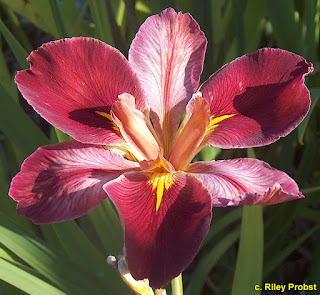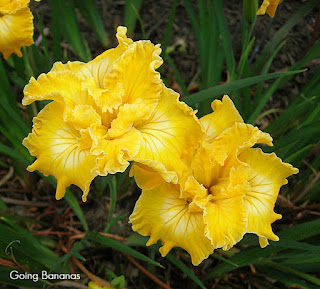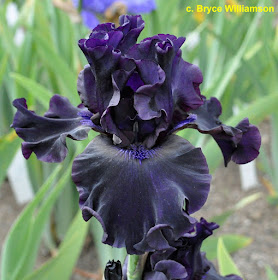By Maggie Asplet
As the
title says, I finally got to come back to the United States and made a visit to Mid-America Garden in Salem, Oregon. It seemed like a lifetime
ago since I was there. Had it really
only been in 2019?
I was all
set to return in 2020, flights booked, and then the world as we knew it came to
an end...or that is what it seemed. March of
2020 had a couple of rather traumatic iris-related events. First, being told that New Zealand
was going to go into lockdown due to coronavirus. Second, during the same week, MPI (our import
regulator) rang to tell me they destroyed seed from
my 2019 crosses by mistake. On top of the hybridizing work being gone, I didn't know when it would be possible to return.
Finally, in 2022, I got to fly away again. This trip certainly had its challenges, such as completing rapid antigen tests before I could travel. On top of this, bloom season in Salem, Oregon included rain, rain, and more rain. Somehow, I did find a way to make some crosses in between the showers.
 |
| Irises during bloom season |
I scheduled my arrival earlier than usual, as I wanted to spend time hybridizing with the standard dwarf bearded irises. The first few days were
spent walking up and down the rows looking at all the wonderful creations produced by Thomas Johnson, Paul Black, and Lynda Miller. Quite mind-boggling really. I'd never seen so many new varieties
in one place. Before I could even begin hybridizing, I had to become familiar with what was there. And what better way than to watch a master at
work. So many beautiful irises. Luckily, there were breaks in the weather to get some crosses made.
 |
| Paul Black hard at work |
Now, I will share some irises that I used in my crosses. I crossed two of Paul Black's miniature tall bearded irises ('Hot Orange' and 'I'm not Timid') with each other, but the others are just examples of smaller irises that were available to “play” with. As to how successful these efforts were, I won’t know until 2024. If I’m lucky it might flower in 2023 and that is only if the cross was successful and a seed pod developed. That is the next stage, waiting to see what did or did not work.
 |
SDB – 'Believe' (Thomas Johnson, 2021)
|
Unfortunately, it was really, really very difficult to get much hybridizing
done. I mean, just look at this next image. Saying it was "wet" is an understatement.
 |
| Walkways between iris rows got very soggy |
Terrible weather during bloom season certainly created many challenges, such as finding something dry to put on my feet. An array of footwear was required.
 |
Something new...
|
 |
| something borrowed (thanks Tim)... |
 |
| ... and something I usually bring with me – jandles*. |
*Jandles –
Inspired by footwear he had seen in Japan, businessman Morris Yock and his son
Anthony began manufacturing this simple rubber footwear in their garage in
1957. The name ‘jandal’ combined the
words “Japanese’ and “sandal.” Thankfully, now I
know where the name comes from.
 |
| Another wet day's occupation was counting irises. Here is Thomas walking the rows, counting and evaluating the damage from the poor weather conditions. |
From my perspective, another great frustration was the lack of flowers; mainly due to the lack of warmth. It was
really hard to believe that weather in Oregon was no warmer than back in New Zealand. Here you were going towards summer, while at home
we were going towards winter and the temperatures were very much the same.
 |
| Irises waiting to bloom |
Due to the lack of flowers in the tall bearded irises, I extended my stay with hope
that they would soon come into flower. Even that was still a great challenge. Before we look at the taller irises, I would like to show you some
images of the wonderful gardens at Mid-America and Sebright Gardens. Some of you may not be aware of the second
business, Sebright Garden, specializing in shade plants from hostas, ferns,
epimediums to fuchsias. Plenty of other
plants as well.
 |
| Beautiful plantings at Sebright |
 |
| Hostas and other shade-loving plants |
 |
| View of Mount Jefferson from the garden |
 |
| Many containers with a wonderful variety of plants |
Finally, I got to see flowers on the taller irises and it was time to get
hybridizing some of the "others", anything from border bearded, to arilbred, to tall bearded.
 |
| Bloom arrives in the bottom field |
 |
| More irises in the house field and the seedling beds |
The above image is the new seedlings for possible introduction in 2023 or
2024. So many gorgeous flowers to choose
from.
.jpg) |
| I was also treated to seeing an American Killdeer Plover – nesting. |
Now, here are images of some of the different ‘bigger’ irises I used. Not necessarily in the same cross.
TB – 'So Hot'
One of my wet weather occupations was making Apple and Rhubarb Crumble –
even some for the freezer.
I always enjoy my trips to Mid-America, as it is a time of catching up
with other members of the American Iris Society. On this occasion, it was the flower show for the Oregon Trail Iris Society. Makes you feel like home and a good time to
join in on a judges' training workshop, this time led by Kevin Vaughan.
The results of some crosses that were made in 2019 at Lynda Miller's of Miller's Manor Gardens never got sent to New Zealand. This time, we
decided I would take them home with me and declare them at the border when
entering New Zealand – NO PROBLEM at all. So, in the future, I will be bringing seeds home with me.
 |
| Stopping to make some last crosses on the morning I left. |
 |
| The field I left behind |
And my last cross – just cause I could.
A very special thank you to Thomas Johnson and Kirk Hansen for putting up with me; it is much appreciated. See you next year.







































.jpg)

















